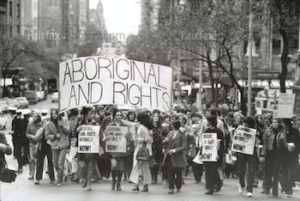
On this date in 2000, in Sydney, Australia, more than 200,000 demonstrators marched to support a campaign for social justice for Aboriginal Australians, the country’s Black community.
This Black ethnic group has lived in Australia for approximately 40,000 years. High above the river of people giving the government its sharpest political message since the Vietnam War demonstrations of the 1970s, a sky-writing plane left a white vapor trail tracing a simple message: “SORRY.” Geoff Clark, chairman of the Aboriginal and Torres Strait Islander Commission, called the showing “a huge success.” Others said it was a mandate to press the government for a formal treaty on the status and rights of the country's 380,000 aborigines.
Aborigines are often referred to as the People of the Dream, as they are said to possess unusual telepathy abilities. When Europeans arrived in Australia in 1788, there were approximately 300,000 Aboriginal people divided into around 500 tribes, which spoke 700 distinct dialects. Australia was first used as a British penal colony, and the whites sent there were either convicts or military guards.
Although the colonial government asked settlers to respect the natives’ rights, the settlers, many ex-convicts who had completed their sentences, were allowed to settle any disputes with the Aborigines without trial. This meant that they were often beaten or killed over any dispute. In 1937, the Commonwealth Government held a national conference on Aboriginal affairs. The Conference agreed that Aboriginal people not of full blood should be absorbed or ‘assimilated into the wider population. Assimilation aimed to make the ‘Aboriginal problem’ gradually disappear so Aboriginal people would lose their identity in the wider community.
Though the Aboriginal people resisted, they were no match for European firepower. The combination of massacres, environmental destruction, and the introduction of European diseases like cholera and influenza reduced the Aboriginal population to 60,000 in the early 20th century.